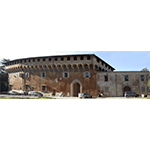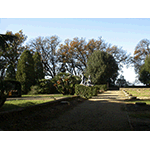Medici Villa at Careggi
Purchased in 1417 by Lorenzo di Giovanni di Bicci de’ Medici, the villa was enlarged around the mid 15th century on a project by Michelozzo di Bartolomeo on order of Cosimo the Elder who loved to spend time here tending the gardens, reading and playing chess. Characterised by a courtyard with a trapezoidal plan, the building was embellished by loggias which placed it in direct contact with the garden and the hilly landscape. Several descriptions of the garden dating to the time of Lorenzo the Magnificent lead us to hypothesise a layout divided into a part with flowers and fruit trees and another with evergreen plants, the so-called selvatico.
The Villa at Careggi was for many years an extraordinarily important cultural centre which hosted, among others, Pico della Mirandola, Agnolo Poliziano and Marsilius Ficinus who here composed the De Vita. It was the seat of the Platonic Academy instituted by Ficinus in 1459 by order of Cosimo the Elder. The main task of the Academy was to attend to the study of the works of Plato and his followers, promoting their diffusion by translating them into Latin. The primary intent of the Academy was also to recover and promulgate ancient scientific texts. The affirmation of Platonism enacted by the academics, acknowledging a geometric and numerical foundation to reality, played a determining role in the evolution of the scientific debate which, by favouring the rediscovery of important mathematical, medical and naturalistic texts from the past, favoured the birth of modern science. These years witnessed, in particular, the recovery and diffusion of the works of Archimedes, the texts of Hippocrates and the writings of Pliny the Elder, of which the copies belonging to the Medici family are today conserved in the Biblioteca Medicea Laurenziana. The Academy’s activity reached its utmost development under the government of Lorenzo the Magnificent who was both a member and its protector. At the Magnificent’s death in 1492, Bernardo Rucellai hosted the Academy in his house, opening the Horti Oricellari to the meetings of its members.
Following the death of Lorenzo, the property suffered a long period of abandon which ended when cardinal Carlo, as of 1615, began a series of works that sited rectangular flower-beds on the south side, embellishing them with box hedges, potted orange trees and fruit trees.
Halfway through the 19th century, the Villa of Careggi became property of Englishman Francis Joseph Sloane, a geologist and scholar of natural sciences, who transformed the park according to the romantic style, enriching it with various exotic tree species still present today, such as the cedars of Lebanon and of the Himalayas, sequoias from California, strawberry trees from Greece and palm trees. This period was also marked by the construction of the lemon-house that conserves the old collection of citrus trees and many varieties of palm. In 1936, the villa was purchased by the Santa Maria Nuova Hospital of Florence which used it first as a nursing school, and then as administrative offices. Today it is the headquarters of the offices of Careggi Hospital.
****************************
Texts by Graziano Magrini
English translation by Victor Beard
Last update 01/set/2010





